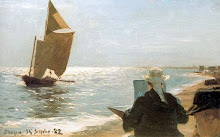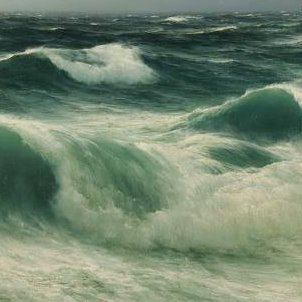Friday, April 30, 2010
Hans Fredrik Dahl - Norwegian, 1849 - 1937
Wednesday, April 28, 2010
Obscurity and Distinctness
Icebergs
Aivazovsky created a mood of mystery and grandeur by leaving some areas of the painting obscured in mist or shadow. He knew where to add detail, and where to leave it out; where to be crisp, and where to be vague.
Poseidon's Sea Journey
Exploding Ship
Exploding Ship
The Survivors
Amidst the Waves
Odessa
Aivazovsky created a mood of mystery and grandeur by leaving some areas of the painting obscured in mist or shadow. He knew where to add detail, and where to leave it out; where to be crisp, and where to be vague.
Thursday, April 22, 2010
Watercolour effects
Occasionally it's worth breaking the 'oils only' theme of this blog to look at some watercolours. These watercolours by the French illustrator Edmund Dulac are for Shakespeare's marine-themed play The Tempest. Watercolour is great for creating nebulous, marbled or bleeding effects to add texture and mystery, especially in backrounds. Similar effects can be achieved with oil paint highly diluted with a solvent such as turpentine or mineral spirit. But beware of the health hazards of breathing solvent fumes. Open windows and use a fan to disperse the fumes, or work outdoors in a breeze. Paint drips are fashionable in contemporary painting, but if you want to avoid them, keep the canvas horizontal when using diluted paint.
Cherry Hood, an Australian artist who won the country's most prestigious portrait prize a few years ago, paints with watercolour on large canvases. This avoids the health issues of using solvents but she has to seal the pigment with vanish because there's no glass to protect it. She uses damar varnish, which presumbly would have to be applied as a spray, brushing it on would smear the watercolour. I would guess there are health issues with spraying varnish too, but the process would be fairly quick and you could wear a mask.
Tuesday, April 20, 2010
Alfred Bricher,
Looking out to Sea
Bricher's skies have a wonderful luminosity to them, and his harmonious compositions are suffused with a mood of tranquility.
Monday, April 12, 2010
Thomas Jacques Somerscales - English 1842-1927
Sunday, April 11, 2010
Thursday, April 8, 2010
Wednesday, April 7, 2010
National Maritime Museum
Herbert Everett, The Deck of the 'Birkdale' in a Storm
From the collection of the National Maritime Museum of Britain.
I've added a link to the online collection in the links bar.
From the collection of the National Maritime Museum of Britain.
I've added a link to the online collection in the links bar.
Tuesday, April 6, 2010
At Pocock Fine Art Gallery
Source: Pocock Fine Art Gallery
Judd Waugh-Frederick, American, Evening Tide, 16 x 22 inches.
Alexander Dzigurski, Serbian, 1885-1967, Crashing Waves at Sunset, 16 x 20 inches.
Robert Gruppe, American, born 1944, Tropical Beach, 30 x 36 inches.
Stanley Woodward, Tropical Seas.
Thursday, April 1, 2010
Space
Fishing Boats at Sea, 50 x 60 cm
German Grobe - German 1857-1938
The shapes of the boats are interesting in themselves, but also the shape of the space between them. It's an interesting exercise to compose a painting with the spaces between objects in mind. Paying attention to the "negative space" around objects is a good way of making sure you are drawing or painting the real shapes of objects, rather than the mind's stored, habitual preconception of what a boat or a wave looks like. In the composition of paintings, spaces between objects are just as important as the shapes of the objects themselves.
In these two works, the German seascape painter German Grobe has filled the narrow space between two boats with bright foam, helping to make the negative space an element in its own right.
A common mistake is to leave to much boring empty space around the objects in a composition so that the negative spaces are lost. The work above shows a good balance between positive shapes and negative spaces. In the work below, Grobe has decided to make the space outweigh the objects, which gives a sense of the sea's power over the fishing boats. The complex textures in the waves and reflective sand make the relatively large space around the objects interesting enough to avoid the problem of lost negative space.
Subscribe to:
Posts (Atom)
























































